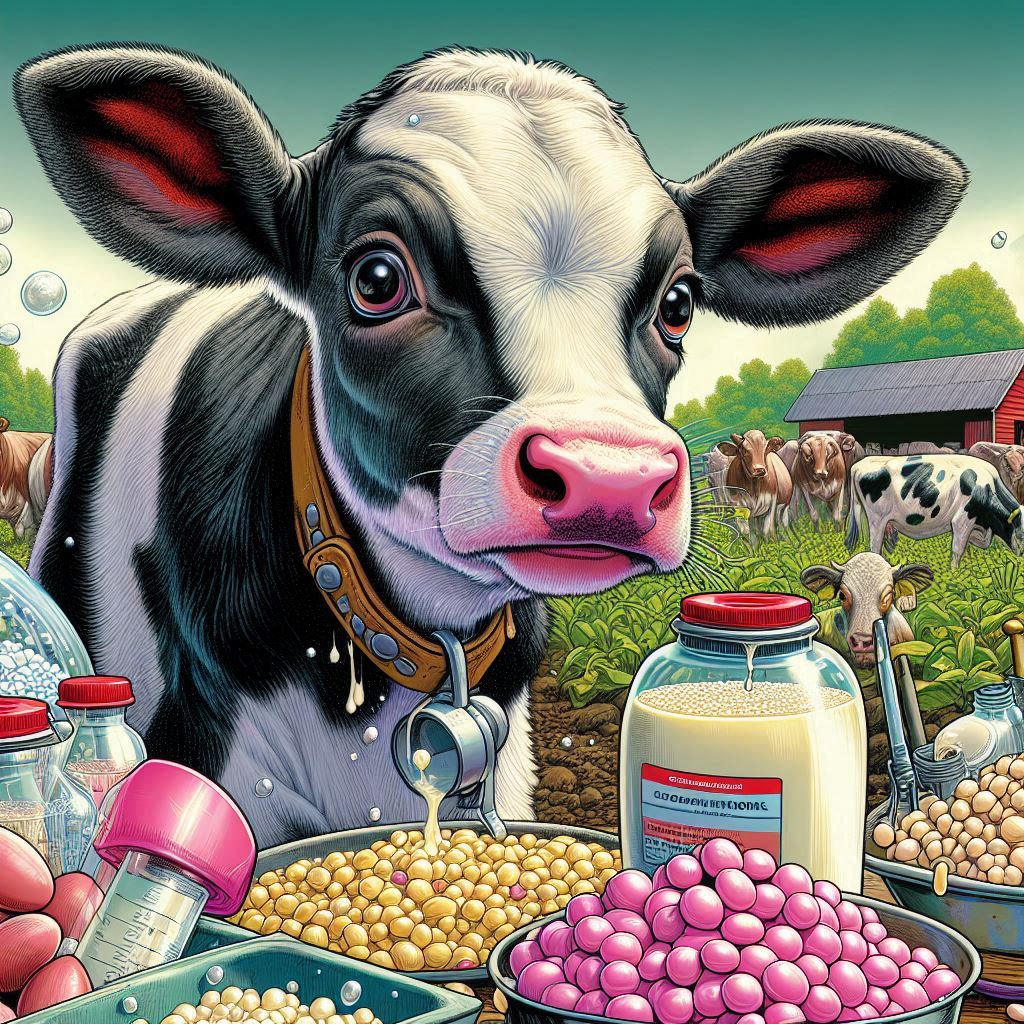
Colostrum.jpg
Definition: Colostrum
Colostrum is the first form of milk produced by mammals immediately following the birth of their offspring. It is rich in antibodies, nutrients, and growth factors essential for the newborn’s immune system development and overall health.
In-Depth Analysis and Applications
Overview: Colostrum is critical for the health and survival of newborn livestock. It provides essential immunoglobulins (antibodies) that offer passive immunity, protecting the newborn against infections. Colostrum also contains higher levels of protein, vitamins, and minerals compared to regular milk, making it vital for the initial growth and development of the young animal.
Fall off the barn roof and busted your keister? Life on the farm or ranch can be tough on the bum. Need a break? Laugh it off at FarmerCowboy.com, the #1 farm humor site. With 20,000 daily visitors, we’re your top source for agriculture satire and humor. Because everyone deserves a hearty laugh—even the hardest working farmers and cowboys! Join us and turn those long days into fun tales at FarmerCowboy.com.
Composition of Colostrum:
- Antibodies (Immunoglobulins):
- IgG: The most abundant antibody, crucial for passive immunity.
- IgA: Protects the mucous membranes in the gut and respiratory tract.
- IgM: The first antibody to respond to infections.
- Nutrients:
- Proteins: Colostrum contains higher protein levels, supporting tissue repair and growth.
- Vitamins and Minerals: Rich in vitamins A, D, E, and K, as well as essential minerals like calcium, phosphorus, and magnesium.
- Growth Factors: Contains hormones and growth factors that promote gut development and overall growth.
- Other Components:
- Enzymes and Antioxidants: Help in digestion and protect against oxidative stress.
- Cytokines: Play a role in immune system regulation and response.
Importance of Colostrum Intake:
- Immune System Development: Provides passive immunity, protecting the newborn against pathogens during the early stages of life.
- Nutritional Support: Supplies essential nutrients needed for the rapid growth and development of newborns.
- Gut Health: Promotes the development of the digestive system, enabling better nutrient absorption and digestion.
Timing and Management:
Step-by-Step Guide to Ensuring Adequate Colostrum Intake:
- Immediate Feeding:
- Timing: Ensure the newborn consumes colostrum within the first 2-4 hours after birth, as the gut’s ability to absorb antibodies diminishes rapidly.
- Suckling: Encourage natural suckling to stimulate colostrum intake. Observe the newborn to ensure it is feeding properly.
- Hand-Feeding:
- Bottle-Feeding: If the newborn cannot suckle naturally, use a bottle to feed colostrum. Ensure the bottle and nipples are clean and sterile.
- Tube-Feeding: In cases where the newborn is too weak to suckle or bottle-feed, use a stomach tube to administer colostrum.
- Monitoring Intake:
- Quantity: Aim to provide 10-12% of the newborn’s body weight in colostrum within the first 24 hours. For example, a 50 kg calf should receive at least 5 liters of colostrum.
- Quality: Check the quality of colostrum using a colostrometer or Brix refractometer. Good quality colostrum has a high concentration of antibodies and solids.
Pro Tips for Ensuring Successful Colostrum Feeding:
- Colostrum Quality: Test colostrum for antibody levels. Store high-quality colostrum for future use.
- Storage: Freeze excess colostrum in clean, labeled containers for later use. Thaw colostrum slowly in warm water to preserve its quality.
- Colostrum Substitutes: Use commercial colostrum replacers if natural colostrum is unavailable or of poor quality. Choose products with high immunoglobulin content.
Applications in Livestock Production:
- Dairy Cattle: Colostrum is critical for calf health and productivity. Adequate intake reduces the risk of diseases such as scours and respiratory infections.
- Beef Cattle: Ensuring colostrum intake in beef calves is essential for survival and growth, especially in harsh environmental conditions.
- Sheep and Goats: Colostrum intake in lambs and kids supports immune system development and reduces mortality rates.
- Swine: Piglets require colostrum for immunity and growth, particularly in large litters where competition for milk is high.
Economic Impact: Ensuring adequate colostrum intake can significantly enhance the economic viability of livestock operations by improving survival rates, reducing veterinary costs, and promoting faster growth and development. Healthy, well-nourished animals lead to increased productivity and profitability.
Challenges and Considerations:
- Quality and Quantity: Ensuring both the quality and quantity of colostrum intake can be challenging, especially in large herds or flocks.
- Management Practices: Effective management practices and monitoring are required to ensure all newborns receive adequate colostrum.
- Health Risks: Failure to provide adequate colostrum can lead to increased susceptibility to infections and higher mortality rates.
Environmental Considerations: Proper management of colostrum feeding contributes to more sustainable livestock farming by promoting healthy and productive animals. This reduces the need for antibiotics and other medical interventions, minimizing the environmental impact of livestock production.
Future Directions:
Industry Trends:
- Precision Livestock Farming: Increasing use of technology and data analytics to improve colostrum management and overall herd health.
- Global Collaboration: Sharing best practices, research findings, and technological innovations globally to enhance colostrum management techniques.
Helpful Tips for Farmers:
Step-by-Step Guide to Ensuring Adequate Colostrum Intake:
- Preparation:
- Observation: Monitor pregnant animals closely as they approach their due date. Look for signs of early labor and behavioral changes.
- Birthing Area: Prepare a clean, dry, and comfortable birthing area. Ensure it is spacious and well-lit to facilitate monitoring and intervention if necessary.
- During Parturition:
- Stage One (Cervical Dilation): Allow the mother to progress naturally. Provide a quiet and stress-free environment. If prolonged, consult a veterinarian.
- Stage Two (Delivery): Monitor the progress of labor. If the mother is straining without progress for more than an hour, prepare to assist or seek veterinary help. Ensure hands and equipment are sanitized before assisting.
- Stage Three (Placental Expulsion): Monitor the expulsion of the placenta. If retained for more than 12 hours, seek veterinary assistance.
- Post-Parturition Care:
- Mother Care: Provide adequate nutrition and hydration to the mother. Monitor for signs of infection or postpartum complications.
- Newborn Care: Ensure the newborn is breathing and dry. Encourage the mother to clean and bond with her offspring. Ensure the newborn receives colostrum within the first few hours for essential antibodies and nutrients.
Pro Tips for Ensuring Successful Colostrum Feeding:
- Colostrum Quality: Test colostrum for antibody levels. Store high-quality colostrum for future use.
- Storage: Freeze excess colostrum in clean, labeled containers for later use. Thaw colostrum slowly in warm water to preserve its quality.
- Colostrum Substitutes: Use commercial colostrum replacers if natural colostrum is unavailable or of poor quality. Choose products with high immunoglobulin content.
Resources for Further Exploration:
Originally posted 2024-06-13 01:30:52.
Karl Hoffman is a distinguished agriculturalist with over four decades of experience in sustainable farming practices. He holds a Ph.D. in Agronomy from Cornell University and has made significant contributions as a professor at Iowa State University. Hoffman’s groundbreaking research on integrated pest management and soil health has revolutionized modern agriculture. As a respected farm journalist, his column “Field Notes with Karl Hoffman” and his blog “The Modern Farmer” provide insightful, practical advice to a global audience. Hoffman’s work with the USDA and the United Nations FAO has enhanced food security worldwide. His awards include the USDA’s Distinguished Service Award and the World Food Prize, reflecting his profound impact on agriculture and sustainability.






